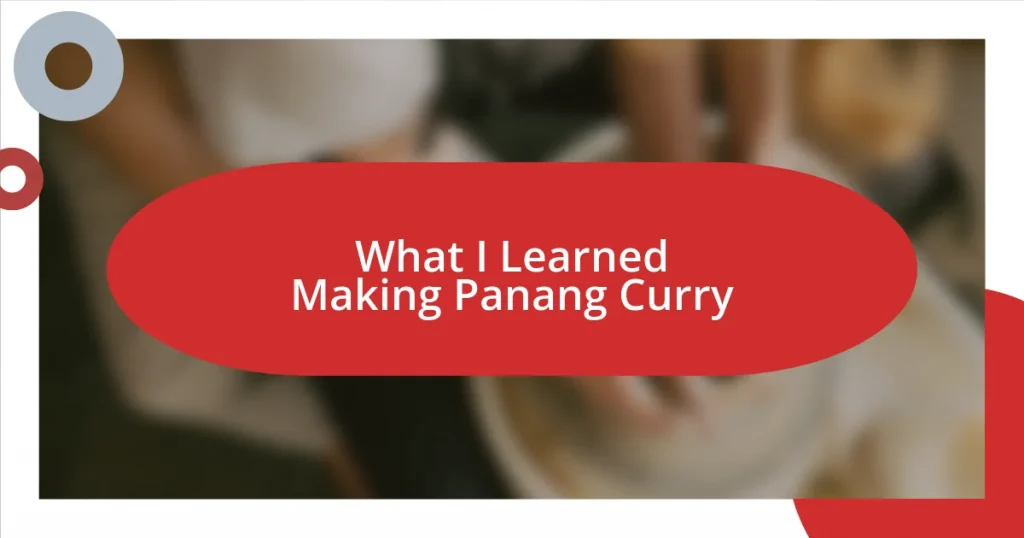Key takeaways:
- Quality ingredients are essential for authentic Panang curry flavor; key components include Panang curry paste, coconut milk, and fresh herbs.
- Patience in cooking, especially during simmering, allows flavors to meld and develop depth, enhancing the overall dish.
- Experimentation and improvisation can lead to delightful surprises in flavor; adjusting spices and trying substitutes can elevate the dish.
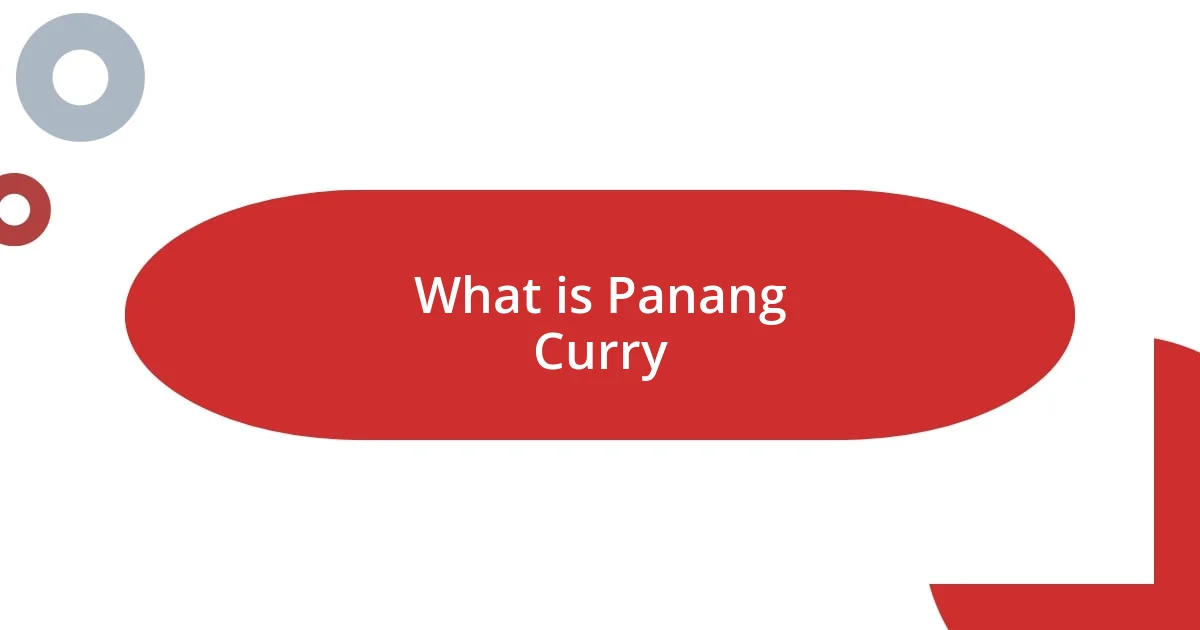
What is Panang Curry
Panang curry is a rich, creamy Thai dish, distinct for its use of thick coconut milk and a unique blend of spices. What sets it apart is the inclusion of Panang curry paste, which combines ingredients like lemongrass, kaffir lime, galangal, and chili peppers. I remember the first time I tasted Panang curry; the warm, aromatic flavor just enveloped me in comfort, almost like a big, cozy hug from my favorite blanket.
The flavor profile of Panang curry strikes a beautiful balance between sweet, savory, and a hint of spice. For me, it’s that combination that makes every spoonful an experience. Have you ever had a dish that instantly reminds you of a place or a person? Panang curry does that for me—evoking memories of a bustling street market in Bangkok, where the air is thick with tantalizing aromas.
Traditionally, Panang curry is made with meat, often beef or chicken, simmered until tender and perfectly infused with the sauce. The way the spices interact creates a comforting warmth that lingers long after the meal is over. Each bite tells a story—a narrative of flavors that connect you to the heart of Thai cuisine. Isn’t it incredible how food can transport us to different times and places?
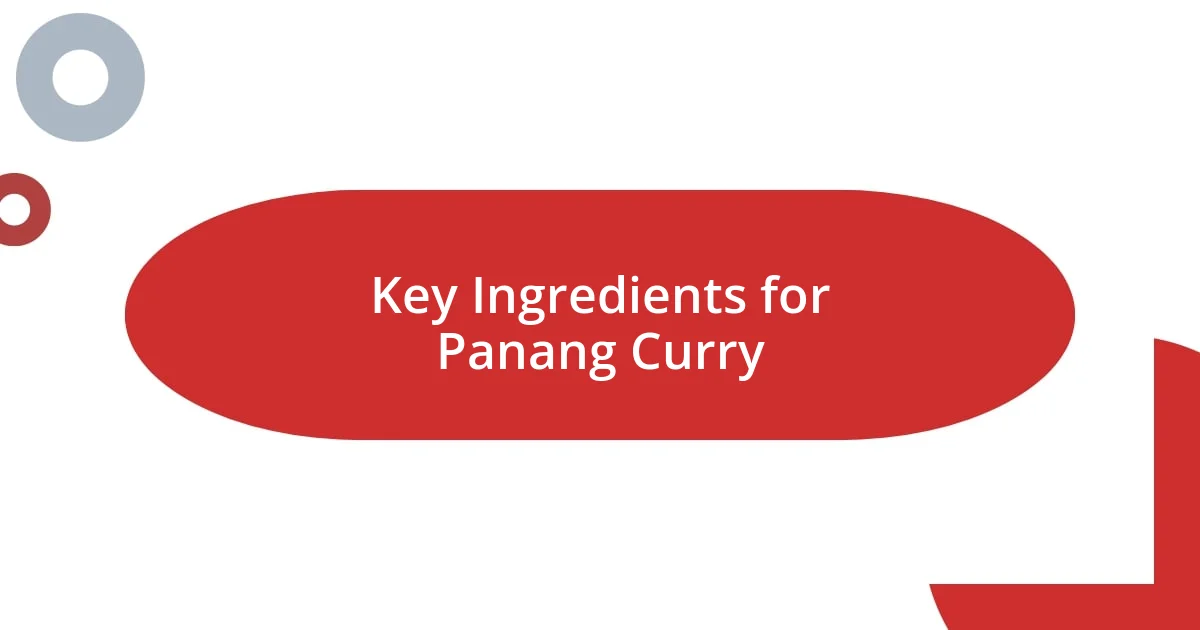
Key Ingredients for Panang Curry
When I first prepared Panang curry, I realized that the quality of the key ingredients is crucial to achieving that authentic flavor. Each element plays a specific role, contributing to that delicious harmony I love so much about it. I remember finding fresh kaffir lime leaves at the local market; the fragrance was so vibrant, I could almost taste the brightness they would bring to the dish.
Key ingredients for Panang curry include:
- Panang curry paste: The heart of the dish, made from blended spices and herbs.
- Coconut milk: Adds richness and creaminess, balancing the spices.
- Meat (often beef or chicken): Provides protein and absorbs the flavors beautifully.
- Kaffir lime leaves: Imparts a unique citrusy aroma that elevates the curry.
- Galangal: A spice similar to ginger with a kick; it enhances the flavor complexity.
- Lemongrass: Adds freshness and a subtle zing.
- Chili peppers: For that desired hint of heat; I often adjust the amount based on my mood!
In exploring these ingredients, I’ve learned to appreciate the nuances they each bring to the table. Stirring in the creamy coconut milk while inhaling the aromatic blend gives me a sense of nostalgia, reminiscent of the times I watched street vendors prepare their curries effortlessly. The beauty of Panang curry lies not only in the cooking technique but also in the care we take in choosing and combining these essential components.

Understanding the Cooking Method
Understanding the cooking method for Panang curry is quite an experience. I’ve found that the technique combines elements of sautéing and simmering, creating a delightful blend of flavors. When I first sautéed the curry paste with coconut milk, it was almost magical; the aroma that filled my kitchen was intoxicating, awakening my senses and drawing me in like a familiar song.
The simmering process is equally important. I learned that allowing the curry to simmer gently helps meld the flavors together beautifully. One time, I let it simmer longer than usual because I got caught up in a favorite show. The end result was a sauce that was deep and rich, far beyond what I had expected. Have you ever unintentionally discovered a new favorite way to prepare a dish? For me, that unexpected twist opened my eyes to how patience can enhance the cooking experience.
Finally, the choice of pan also matters—a heavy-bottomed wok or pot works wonders for even heat distribution. I remember the first time I tried it in a regular saucepan and how it didn’t quite deliver that beautifully thick consistency I craved. After switching to a deeper, heavier pot, I felt as though I had finally unlocked the true potential of the dish, transforming my cooking into something I was genuinely proud of.
| Cooking Method | Description |
|---|---|
| Sautéing | Begin by sautéing the curry paste with coconut milk to release the flavors. |
| Simmering | Simmer the mixture to meld the spices and ingredients, creating depth. |
| Choosing the Right Pan | A heavy-bottomed pot ensures even heat distribution for a thick consistency. |
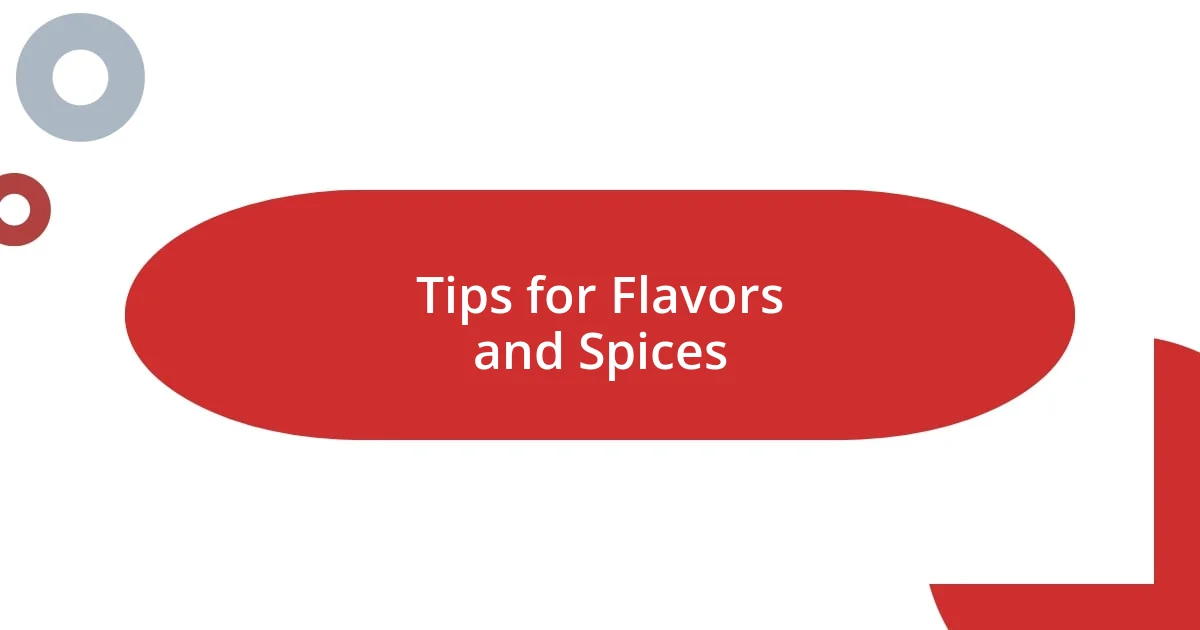
Tips for Flavors and Spices
When it comes to balancing flavors in Panang curry, I’ve discovered that a little experimentation goes a long way. For instance, I once added a touch of palm sugar to the mix, and it transformed the dish entirely. That sweet contrast made me think about how flavors intertwine to create something truly beautiful. Have you ever adjusted a recipe and stumbled upon a delightful surprise?
Another tip I’d share is to embrace the spices at various stages of cooking. Adding fresh herbs like cilantro or Thai basil right at the end can elevate the dish with a burst of freshness. I remember the first time I sprinkled freshly chopped basil on top just before serving; it was like the final brushstroke on a masterpiece. The aroma was so inviting, it felt like the curry was beckoning everyone to gather around the table.
Also, pay attention to the heat levels. I learned the hard way that not all chili peppers offer the same heat. The first time I used Thai bird’s eye chilies, I was unprepared for the intensity! While I appreciate a good kick, moderation is key. Now I taste as I go, adjusting the spice to suit my palette, ensuring an enjoyable experience for everyone at the table. How do you navigate the spice levels in your cooking? For me, it’s all about balance—finding the sweet spot that makes my taste buds sing.

Common Mistakes to Avoid
One common mistake I made when crafting Panang curry was neglecting to taste as I went along. At one point, I dutifully followed the recipe, adding salt without even sampling the dish. When I finally took that first bite, I was taken aback by how overpowering it was. Now I constantly remind myself that tasting and adjusting throughout the cooking process is crucial for achieving that perfect harmony of flavors. Have you ever faced a similar situation where you wished you’d checked in on your creation earlier?
Another pitfall to avoid is rushing the sautéing phase. There was a time when I hurriedly tossed my curry paste into the pan, eager to get to the simmering part. The result? A dish that lacked the depth of flavor I craved. Letting the paste truly break down and mix with the coconut milk allows those essential oils to release. The scent that wafts through the kitchen is truly worth the wait—and it sets the stage for that magical tasting experience.
Lastly, don’t overlook the importance of using fresh ingredients. I once grabbed a jar of pre-made curry paste out of sheer convenience, thinking it would save me time. While it was easy, the flavor was flat and one-dimensional compared to making my own. Fresh ingredients bring life to the dish, offering vibrant aromas and rich flavors that jarred alternatives simply can’t match. Have you experienced the stark difference between the two? I certainly have, and it’s why I now prioritize fresh over fast when preparing my curry.
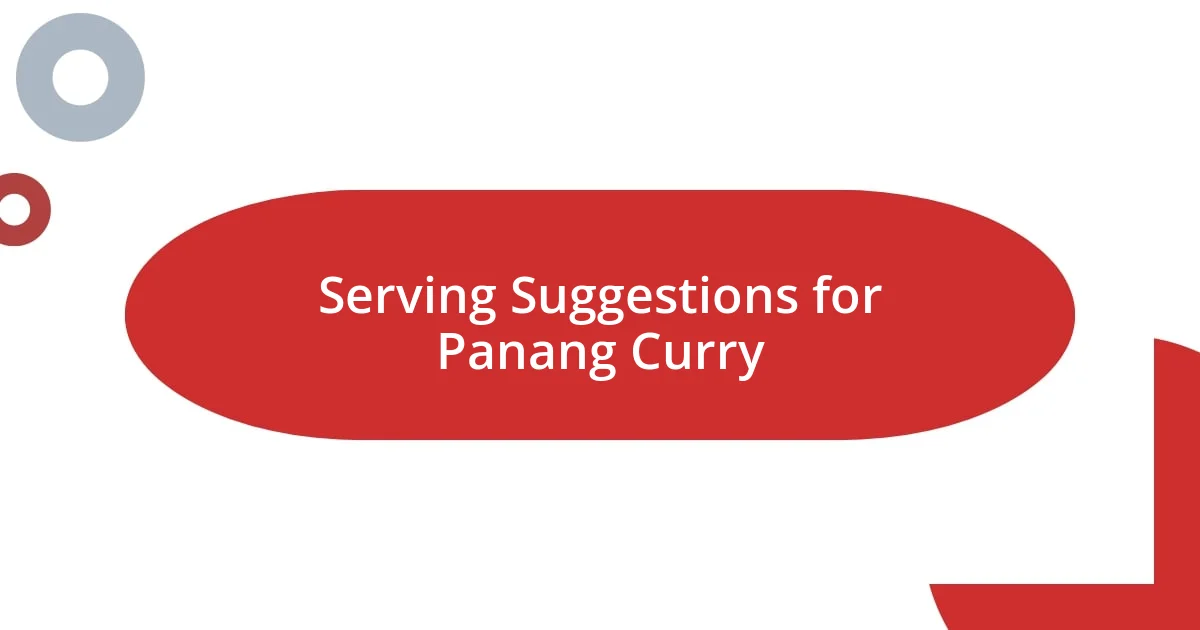
Serving Suggestions for Panang Curry
When serving Panang curry, I’ve found that presentation can truly enhance the dining experience. Serving the curry in a beautiful bowl, garnished with fresh herbs, not only looks appealing but also sets the mood for an exciting meal. I remember the first time I arranged everything on a wooden platter—it transformed a simple dinner into an event, inviting my guests to dive into a feast of colors and aromas. How do you present your dishes? For me, it’s all about creating an inviting atmosphere.
Pairing the curry with the right sides is another crucial aspect. I usually serve Panang curry alongside jasmine rice to soak up that rich, flavorful sauce. There’s something about the fluffy rice that balances the creaminess of the coconut milk. One time, I even paired it with roti, which added a delightful texture and allowed my friends to scoop up the curry. Have you found any unexpected combinations that work well? It’s interesting how a simple side can elevate the entire meal.
Lastly, don’t forget about the importance of beverages. I’ve experimented with various drinks, and I’ve discovered that a cold Thai iced tea or a light beer can complement the curry beautifully. I vividly recall enjoying my Panang curry with a refreshing glass of homemade lemonade that countered the heat perfectly. What has been your go-to beverage that enhances the dish? It’s these thoughtful pairings that create a memorable meal, drawing everyone into the flavors on the table.

Personal Insights and Lessons Learned
Learning to make Panang curry has been a journey filled with moments of revelation. One of my biggest takeaways has been the significance of precision in measurements. I remember the excitement when I eyeballed my spice quantities, only to be left with a curry that was too spicy and not quite right. It taught me that in cooking, especially with bold flavors, a little can go a long way. Have you ever been surprised by how one ingredient can dominate a dish?
As I experimented, I discovered the power of patience. I once rushed through the simmering stage, anxious to taste my creation. When I finally dug in, I realized the flavors had yet to meld into that truly delicious experience I was hoping for. Now, I embrace that simmering time, using it as an opportunity to unwind and reflect. Has there been a moment in your cooking where you learned that waiting can lead to something amazing?
Another insight I’ve gained revolves around the art of improvisation. I remember a day when I was out of coconut milk and had to substitute with plain yogurt instead. To my surprise, it added a tangy twist that my friends couldn’t stop raving about! That moment opened my eyes to the exciting possibilities of being flexible with ingredients—sometimes the best outcomes arise from unexpected choices. What’s your favorite culinary surprise?










